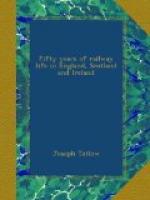On the twenty-second day after leaving home, at six o’clock in the morning, we were aroused in our berths and informed that we had arrived at Constantinople. The morning, unfortunately, was dull, and our first view of the Ottoman city, therefore, a little obscured. All the same, it was a great sight, with its minarets and towers, its Golden Horn and crowded quays. Our dragoman kept at bay all the clamouring crowd of porters, guides and nondescripts of all colours and races that besieged us. It was 8.30 a.m. when we landed, but 3.30 p.m. by Turkish time. The Moslem day is from sunset to sunset, and sunset is always reckoned 12 o’clock; an awkward arrangement which the reforming “Young Turk” perhaps has since altered. The week we spent in Constantinople was all too short. We stayed at the Pera Palace Hotel, and the first night after dinner, in our innocence, strolled out. All was dark and dismal; no one in the streets. We went as far as the quays, strolled back and on the way called at a small cafe, the only inmate of which was a dwarf, as remarkable looking as Velasquez’s Sebastian de Morra. The hall porter at our hotel was waiting our return with anxiety. “It was not safe to be out at night,” he said; “we had gold watches on us and money in our purses, and knives were sharp.” Murray’s guide book, we afterwards found, gave similar warning, without mentioning knives. Sir Nicholas O’Connor was our Ambassador in Constantinople. He was an Irishman from County Mayo, and I had a letter of introduction to him from my friend Sir George Morris. Sir Nicholas invited me to lunch at Therapia, where the Embassy was in residence in its summer quarters. He was exceedingly kind and facilitated our sightseeing in the great city during our stay. We witnessed the Selamlik ceremony of the Sultan’s weekly visit for prayers to the Mosque Hamedieh Jami, which stands adjacent to the grounds of Yildiz Kiosk. It was worth seeing. There was a great gathering of military in splendid uniforms and glittering decorations. Seven handsome carriages contained his principal




